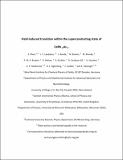Files in this item
Field-induced transition within the superconducting state of CeRh2As2
Item metadata
| dc.contributor.author | Khim, S | |
| dc.contributor.author | Landaeta, J F | |
| dc.contributor.author | Banda, J | |
| dc.contributor.author | Bannor, N | |
| dc.contributor.author | Brando, M | |
| dc.contributor.author | Brydon, P M R | |
| dc.contributor.author | Hafner, D | |
| dc.contributor.author | Küchler, R | |
| dc.contributor.author | Cardoso-Gil, R | |
| dc.contributor.author | Stockert, U | |
| dc.contributor.author | Mackenzie, A P | |
| dc.contributor.author | Agterberg, D F | |
| dc.contributor.author | Geibel, C | |
| dc.contributor.author | Hassinger, E | |
| dc.date.accessioned | 2022-05-09T11:30:22Z | |
| dc.date.available | 2022-05-09T11:30:22Z | |
| dc.date.issued | 2021-08-26 | |
| dc.identifier | 275694690 | |
| dc.identifier | fe2ae1a9-0a9d-4380-a962-cb5c98a22052 | |
| dc.identifier | 85113739433 | |
| dc.identifier | 000690202600034 | |
| dc.identifier.citation | Khim , S , Landaeta , J F , Banda , J , Bannor , N , Brando , M , Brydon , P M R , Hafner , D , Küchler , R , Cardoso-Gil , R , Stockert , U , Mackenzie , A P , Agterberg , D F , Geibel , C & Hassinger , E 2021 , ' Field-induced transition within the superconducting state of CeRh 2 As 2 ' , Science , vol. 373 , no. 6558 , pp. 1012-1016 . https://doi.org/10.1126/science.abe7518 | en |
| dc.identifier.issn | 0036-8075 | |
| dc.identifier.other | RIS: urn:5B6C435CA8B7F27052660CEEE68A383F | |
| dc.identifier.uri | https://hdl.handle.net/10023/25319 | |
| dc.description | Funding: We acknowledge funding from the Physics of Quantum Materials department and the research group “Physics of Unconventional Metals and Superconductors (PUMAS)” of the Max Planck Society. C.G. and E.H. acknowledge support from the German Science Foundation (DFG) through grant GE 602/4-1 Fermi-NESt. P.M.R.B. was supported by the Marsden Fund Council from Government funding, managed by Royal Society Te Apārangi. R.K. is supported by the DFG through project. no. KU 3287/1-1. D.F.A. was supported by the US Department of Energy, Office of Basic Energy Sciences, Division of Materials Sciences and Engineering, under award DE-SC0021971. | en |
| dc.description.abstract | Materials with multiple superconducting phases are rare. Here, we report the discovery of two-phase unconventional superconductivity in CeRh2As2 Using thermodynamic probes, we establish that the superconducting critical field of its high-field phase is as high as 14 tesla, even though the transition temperature is only 0.26 kelvin. Furthermore, a transition between two different superconducting phases is observed in a c axis magnetic field. Local inversion-symmetry breaking at the cerium sites enables Rashba spin-orbit coupling alternating between the cerium sublayers. The staggered Rashba coupling introduces a layer degree of freedom to which the field-induced transition and high critical field seen in experiment are likely related. | |
| dc.format.extent | 5 | |
| dc.format.extent | 995600 | |
| dc.format.extent | 1137938 | |
| dc.language.iso | eng | |
| dc.relation.ispartof | Science | en |
| dc.subject | QC Physics | en |
| dc.subject | DAS | en |
| dc.subject | AC | en |
| dc.subject.lcc | QC | en |
| dc.title | Field-induced transition within the superconducting state of CeRh2As2 | en |
| dc.type | Journal article | en |
| dc.contributor.institution | University of St Andrews. School of Physics and Astronomy | en |
| dc.contributor.institution | University of St Andrews. Condensed Matter Physics | en |
| dc.identifier.doi | 10.1126/science.abe7518 | |
| dc.description.status | Peer reviewed | en |
This item appears in the following Collection(s)
Items in the St Andrews Research Repository are protected by copyright, with all rights reserved, unless otherwise indicated.


